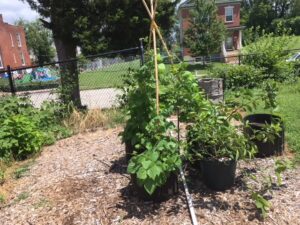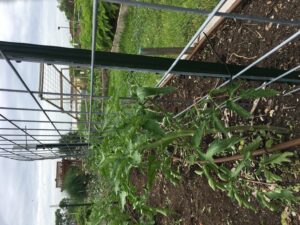June Tip: Vertical Gardening

What if I told you there was a way to increase vegetable production without increasing garden size and that it would also reduce disease without using any fertilizers or pesticides. Sounds like a marketing scam but it’s not, it’s vertical gardening. Training and supporting plants that would normally sprawl over a large area of the garden to instead grow upright can do all of this.
How can growing things upright increase production and reduce disease? By offering support to plants that would normally sprawl on the ground you can oftentime plant more things in the same space than if they were not upright. This can mean more production. Growing them upright can also increase production by increasing the amount of light the leaves receive. Lastly, training plants to grow upright can greatly increase airflow over the plant. This increased airflow can reduce the incidence of disease, particularly mildew or other fungal diseases. Reduced disease issues can also increase production of your plants.
The most critical part of vertical gardening is trellising. It is the support provided by trellises that allows you to train plants to grow upright. There are countless ways to support plants, but two of our favorites are metal fencing and stakes. Together these two trellising systems make excellent trellises for anything that you would like to grow vertically. Stakes are good for light vining plants like beans and metal fencing is great for heavier larger plants like squash, melons, and tomatoes.

Stakes are probably one of the oldest ways of trellising. A stake is simply a pole that you push into the ground. Stakes can be made of many different materials. One of the most common you will find in the store are fiberglass or metal stakes that have a plastic coating on them. Another very popular material that we really like is bamboo. However, you can also simply use a branch or stick from a tree or shrub growing in your backyard as a stake. To use a stake simply push it into the ground close to the stem of the plant you wish to trellis.
Stakes are used in two primary ways. One is to be a trellis for long vining things and the other is to stabilize shorter things that stand upright but are prone to topple over. In the first case long stakes are great for growing vining plants that naturally climb like pole beans, peas, and malabar spinach. Pole beans, peas, and malabar spinach will grow up a stake on their own without assistance, all you need to do is push the stake into the ground right next to one of these plants and it will grow right up.
The other way to use stakes is as a plant support. For this purpose you push a stake into the ground next to the main stem of a plant and tie the stem of that plant to the stake. This provides extra strength to the stem of the plants, helping bushy fruiting crops that are prone to fall over under the weight of their fruit to remain upright. This is most commonly used for peppers, eggplant, tomatillos, and ground cherries.

Metal fencing is our other favorite trellising material and the heavier the wire used the better. Heavy metal fencing like cattle paneling is strong enough that you can easily trellis even very heavy things like watermelon. Lighter weight fencing like metal fencing that comes in rolls will hold heavy things but they will bend the fence as they get heavy. If the posts supporting the fence aren’t very secure the whole trellis can blow over in a storm, and that’s a mess you do not want to deal with. Metal fencing is great for trellising tomatoes, winter squash, melons, tromboncino squash, pumpkins, and cucumbers. These plants won’t usually grow on the fence on their own. To trellis these plants simply weave the vines or stems in and out of the fence as they grow to keep them growing up instead of sprawling on the ground.
An important thing to know about when it comes to vertically growing plants is that some need additional support for their fruit. Things like cucumbers, tomatoes, tromboncino squash, and small fruited squash like baking pumpkins and butternuts can be trellised and their fruit can hang off the vine without any problems. However, if you are growing any very large squash or any melons you will need to offer the fruit extra support. If you just let the fruit hang off the vine there is likely to come a time when they are growing that they will fall off the vine due to their weight, before they are ripe. The best way to provide this support is to create a “hammock.” This is simply a piece of fabric, anything from a piece of burlap to an old t-shirt or piece of scrap fabric that you place under the developing melon or squash and then tie the sides to the trellis to hold up the fruit so it won’t fall.
So those are the basics of vertical gardening. If you want to maximize your growing space and enjoy growing things like beans, peas, malabar spinach, peppers, eggplant, tomatillo, ground cherry, tomato, squash, pumpkins, melons, or cucumber then you should keep some metal fencing and stakes on hand. Use the stakes to support light vining crops or to stabilize bushy fruiting crops to allow them to grow upright. Weave the stems of vining squash, melons, and tomatoes through the holes in metal fencing to get them to grow upright instead of letting them swallow your whole garden and beyond. If you do this you could increase your garden’s production while also reducing the disease pressure your garden faces.

